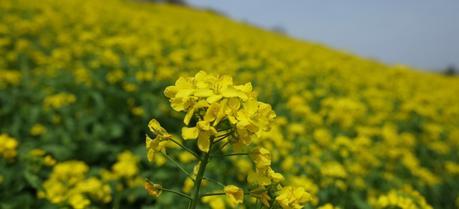 Heat-responsive genes are responsible for flowering time in Australian spring-type canola. (Credit: Flickr @ ★Kumiko★ https://www.flickr.com/photos/kmkmks/)
Heat-responsive genes are responsible for flowering time in Australian spring-type canola. (Credit: Flickr @ ★Kumiko★ https://www.flickr.com/photos/kmkmks/)Scientists have identified that heat-responsive genes are responsible for flowering time in Australian spring-type and European summer-type canola.
A problem that has puzzled canola breeders for years has been solved by researchers from The University of Western Australia—and the results could provide a vital breakthrough in understanding the impact of increasing global temperatures on crop flowering.
SEE ALSO: Miscanthus to Play a Major Role in Iowa Agriculture
The key to understanding what makes Australian canola flower earlier than its Canadian and European counterparts lies in the genes.
Associate Professor Matthew Nelson from UWA’s Institute of Agriculture and School of Plant Biology has identified that heat-responsive genes are responsible for flowering time in Australian spring-type and European summer-type canola. This is the first time such genes have been reported to influence flowering time in canola.
Australian canola is quite distinct from its Canadian and European counterparts – it flowers much earlier. Plant breeders cannot simply transfer varieties from Canada or Europe into Australia as they flower much too late for the Australian environment.
“We took a European summer-type canola, crossed it with Monty, a typical early flowering Australian variety, and analyzed the progeny for variation in flowering time,” Associate Professor Nelson said.
“There was a huge variation from about 30 days to 160 days in our typical Australian environment. This was totally unexpected and we showed there are several forms of these heat-responsive genes controlling flowering time.”
The research indicated that the European plants required much more accumulated heat (thermal time) to flower than the Australian plants.
“Until now, most researchers assumed that long summer days in Europe and Canada triggered flowering, not heat,” Associate Professor Nelson said. “Now we know that long days are only a minor part of the story.”
“Understanding this complex process is important as breeders alter the adaptation of crops to a new and changing environment,” research team leader Winthrop Professor Wallace Cowling said. “International canola breeders will use this information to re-establish the correct flowering time in canola when they cross between Australian types and summer annual types in the northern hemisphere.
“With increasing global temperatures, or in low rainfall environments, it will be possible to ‘mix and match’ forms of these heat genes to achieve the target flowering date.”
Since day-length affected both European and Australian varieties equally, the research group can now focus on heat genes to predict the outcomes from crossing European or Canadian canola with Australian canola and explain what caused these genes to respond to accumulated heat.
Nelson, M., Rajasekaran, R., Smith, A., Chen, S., Beeck, C., Siddique, K., & Cowling, W. (2014). Quantitative Trait Loci for Thermal Time to Flowering and Photoperiod Responsiveness Discovered in Summer Annual-Type Brassica napus L PLoS ONE, 9 (7) DOI: 10.1371/journal.pone.0102611
